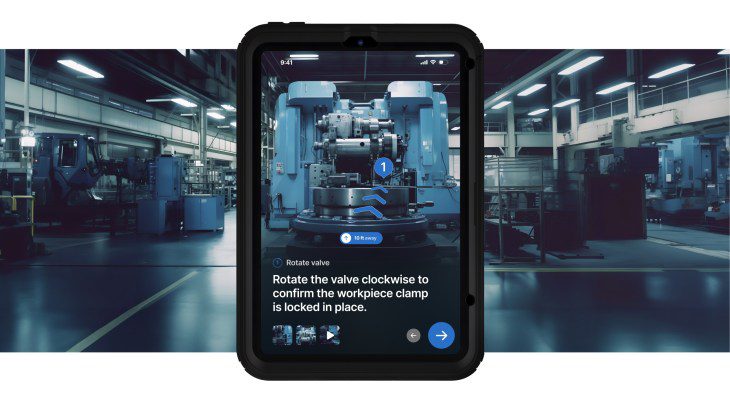TL;DR:
- Squint secures $13 million in a Series A funding round led by Sequoia, with Menlo Ventures participating.
- Apple and Google’s prior foray into AR paved the way for Squint’s innovative approach.
- Squint focuses on simplifying AR-based workflows for business users, utilizing smartphone cameras to interact with physical objects.
- Large enterprises like Volvo, Siemens, and Colgate-Palmolive are already leveraging Squint for workflow management.
- Squint aims to eliminate the need for traditional search methods, revolutionizing access to information.
- Founder Devin Bhushan’s journey from Splunk AR to Squint underscores the potential of AR technology.
- Squint distinguishes itself by addressing object detection and content creation from scratch.
- The platform offers dynamic, specific workflows with AI support for object recognition and interactive queries.
Main AI News:
In the ever-evolving landscape of smart augmented reality, Squint emerges as a leading player, targeting the B2B sector with a vision to revolutionize the way we interact with physical objects. With a recent Series A funding round raising $13 million, led by Sequoia and backed by Menlo Ventures, Squint is poised to accelerate its growth and technological advancements.
The Shift in AR Landscape by Apple and Google
Apple and Google have played pivotal roles in popularizing augmented reality by harnessing smartphone cameras to recognize and interact with everyday objects. This paradigm shift not only captured the imagination of consumers but also opened new doors for businesses to craft innovative experiences. It set the stage for the emergence of groundbreaking advancements in visual search technology.
Squint’s Vision: Connecting People with Information
Devin Bhushan, the founder and CEO of Squint, envisions a future where people effortlessly access the right information at the right time. Squint, initially focusing on catering to business users, has designed a user-friendly platform for organizations to build augmented reality-based workflows. By simply pointing their smartphone or tablet cameras at physical objects within their work environment, users can activate detailed, step-by-step instructions, record maintenance tasks, and leverage generative AI-based interactions to acquire essential knowledge.
A Customer Base Comprising Industry Giants
Squint has already garnered the trust of several major enterprises, including Volvo, Siemens, Colgate-Palmolive, Michelin, and Berkshire Hathaway Energy. These industry leaders rely on Squint to streamline workflows in factory and industrial settings. While B2B remains Squint’s initial focus, the company has a broader mission in mind.
Eliminating the Search Bar: Squint’s Ultimate Goal
Contrary to its name, Squint aspires to eliminate the need to search for information and data. Bhushan’s journey to founding Squint began during his tenure as an engineering manager at Splunk, where he contributed to the development of Splunk AR. This tool enabled users to map data directly onto physical machines, enhancing real-time understanding of their operations.
A Shift Towards Mass Adoption
While Splunk AR was well-received, its applications were limited to visualizing Splunk data. Bhushan recognized a broader potential for AR technology in various workflows outside of Splunk’s scope. This realization marked the genesis of Squint, which aimed to bring AR to the masses and unlock new possibilities.
Innovations at Squint
Unlike Splunk, Squint tackled the object detection aspect and content creation from scratch. Leveraging computer vision and object detection, Squint converts videos into AR procedures. The company’s unique approach offers dynamic and specific workflows tied to precise actions and machine system components. It incorporates AI not only for object recognition but also for guiding users through workflows and facilitating interactive queries.
A Dynamic Solution for Industrial Work
Squint’s solution stands out by providing a dynamic and specific approach for businesses. Companies can create workflows seamlessly, linking them to precise user actions and machine components. The AI within Squint extends beyond object recognition, supporting users in their workflows and enabling them to seek answers effectively.
A Collaborative Journey
Bhushan’s journey began with incubating Squint at Menlo Ventures, with support from Tim Tully, a partner at the firm and former CTO of Splunk. Squint also formed a valuable connection with the Sequoia team during its participation in Arc, Sequoia VC’s early-stage program. Both Menlo Ventures and Sequoia are previous investors in Squint.
Building the Future of Skilled Labor
Jess Lee, a partner at Sequoia, highlights the significance of tools like Squint for skilled laborers. Whether it’s for inventory management, machine maintenance, or other tasks, Squint demonstrates how technology can seamlessly integrate into the offline world, transcending the boundaries of AI and AR. In these scenarios, the focus shifts to efficiency and productivity, rather than the technology itself.
Conclusion:
Squint’s successful funding round and its growing adoption by major enterprises signal a promising future for AR in the B2B market. By streamlining workflows and enhancing access to information, Squint is poised to revolutionize how businesses interact with their physical surroundings. This development highlights the increasing importance of AR technology in optimizing productivity and efficiency for industrial and hands-on roles, paving the way for further innovations in the market.

